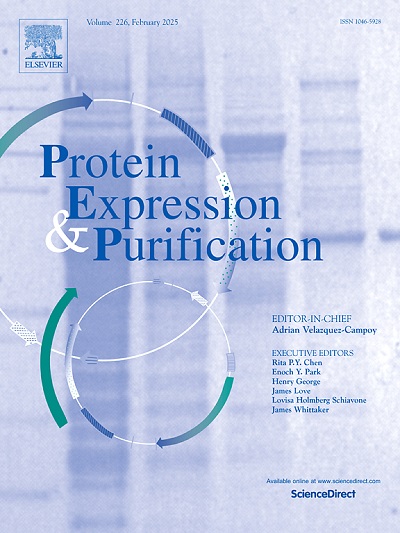Preparation and characterization of LGR5 LOOP region-specific nanobodies
IF 1.2
4区 生物学
Q4 BIOCHEMICAL RESEARCH METHODS
引用次数: 0
Abstract
Leucine-rich repeat-containing G-protein-coupled receptor 5 (LGR5), also known as G-protein-coupled receptor 49 (GPR49), is a class A G-protein-coupled receptor (GPCR) that plays a pivotal role in embryonic development and functions as a marker for adult stem cells in various tissues and organs. LGR5 possesses a large extracellular domain (ecto-domain) enriched with leucine-rich repeats (LRR), primarily responsible for binding to ligands such as R-spondins. The C-terminal LRR extracellular LOOP region of LGR5 refers to the loop structure connecting the C-terminus of LGR5 to the first transmembrane helix. As the LOOP region is located extracellularly, it is readily accessible to exogenous molecules such as antibodies, nanobodies, or small-molecule drugs. In this study, we successfully expressed and purified the LGR5 LOOP region protein in a prokaryotic expression system. The purified protein was subsequently used as an antigen to immunize camels, leading to the generation of nanobodies. These nanobodies are composed solely of the variable domain of the heavy-chain antibody (VHH), with a molecular weight of approximately 15 kDa. Using the purified LGR5 LOOP region protein as an antigen, we isolated nanobodies that specifically bind to it. Subsequent assays demonstrated that the selected nanobody, NB 4C4 and NB 3E8, specifically targeted the LGR5 LOOP region, exhibited an inhibitory effect on β-catenin-mediated Wnt signaling to a certain extent. This study provides insights for the development of LGR5-targeted diagnostic reagents and antibody-based therapeutic strategies.
LGR5 LOOP区域特异性纳米体的制备与表征
Leucine-rich repeat-containing G-protein-coupled receptor 5 (LGR5),又称G-protein-coupled receptor 49 (GPR49),是一类G-protein-coupled receptor (GPCR),在胚胎发育过程中起关键作用,并在多种组织器官中作为成体干细胞的标志物。LGR5具有一个大的胞外结构域(ecto-domain),富含亮氨酸重复序列(LRR),主要负责与R-spondins等配体结合。LGR5的c端LRR胞外LOOP区是指连接LGR5的c端与第一跨膜螺旋的环结构。由于LOOP区域位于细胞外,外源分子如抗体、纳米体或小分子药物很容易进入。LGR5的LOOP区调节受体构象变化,从而影响信号转导,参与细胞功能的调控。在本研究中,我们成功地在原核表达系统中表达并纯化了LGR5 LOOP区域蛋白。纯化后的蛋白质随后被用作免疫骆驼的抗原,从而产生特异性纳米体。这些纳米体仅由重链抗体(VHH)的可变结构域组成,分子量约为15 kDa,具有优异的稳定性。使用纯化的LGR5 LOOP区域蛋白作为抗原,我们分离出特异性结合的纳米体。随后的实验表明,所选择的纳米体NB 4C4和NB 3E8对抗原具有高亲和力,并特异性靶向LGR5 LOOP区域,有效抑制β-catenin介导的Wnt信号传导,对β-catenin介导的Wnt信号传导有一定程度的抑制作用。本研究为lgr5靶向诊断试剂和基于抗体的治疗策略的开发提供了实质性的证据见解。
本文章由计算机程序翻译,如有差异,请以英文原文为准。
求助全文
约1分钟内获得全文
求助全文
来源期刊

Protein expression and purification
生物-生化研究方法
CiteScore
3.70
自引率
6.20%
发文量
120
审稿时长
32 days
期刊介绍:
Protein Expression and Purification is an international journal providing a forum for the dissemination of new information on protein expression, extraction, purification, characterization, and/or applications using conventional biochemical and/or modern molecular biological approaches and methods, which are of broad interest to the field. The journal does not typically publish repetitive examples of protein expression and purification involving standard, well-established, methods. However, exceptions might include studies on important and/or difficult to express and/or purify proteins and/or studies that include extensive protein characterization, which provide new, previously unpublished information.
 求助内容:
求助内容: 应助结果提醒方式:
应助结果提醒方式:


